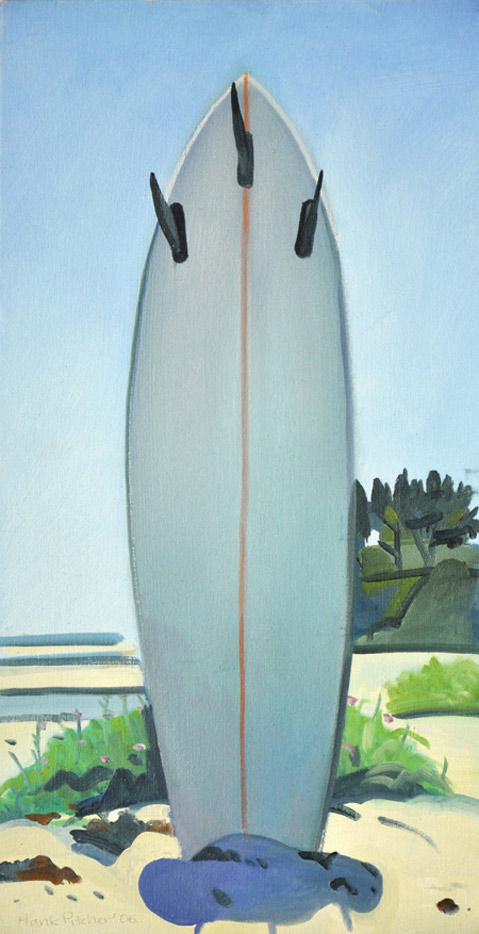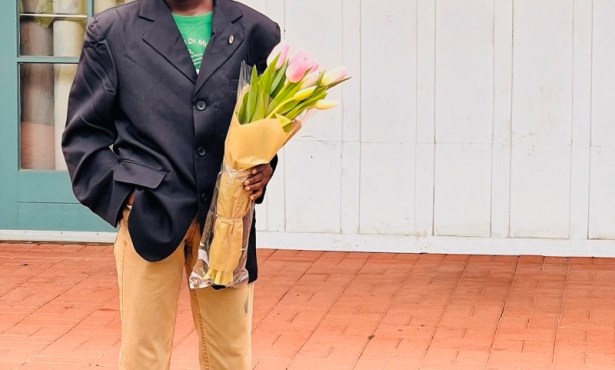Review: Hank Pitcher: The Long View
On View at Sullivan Goss, An American Gallery through February 2, 2014

Why paint landscape? Hank Pitcher has an answer that may be more far-reaching and interesting than any previously offered. To say that Pitcher is a painter of California landscapes is like saying Monet painted water lilies. Pitcher’s work reflects the legacy of plein-air painting while being influenced by the sparse realism of Edward Hopper and the echoes of WPA artists. Overlooked is his compelling relationship to the pivotal abstract expressionist Richard Diebenkorn, who was equally drawn to landscapes both abstract and representational.
In their synthesis of natural and formal, these powerfully constructed pictures at Sullivan Goss — the first since his 40-year retrospective at the Wiegand Gallery eight months ago — are startling for their clarity and simplicity. The exhibit includes a number of small pieces, several large landscapes, and one 17-foot-long work. Each painting has a focus and tension that creates figurative, formal, historical, and emotional levels within — all fused together in a way that demands to be taken on its own terms. This is landscape as a springboard for a discourse on perception and painting.

“Sedgwick Valley Evening,” one of the midsize canvases, depicts the rolling and rollicking hills of Sedgwick Reserve. The rises lay sensuously along each other like naked bodies across the land, contrasting sharply with the flat roads and thin wooden fences in the foreground. Three tiny clouds linger like grace notes at the top of the farthermost mountain and focus the movement of the entire work.
From a distance, “S-Tubes” depicts the underside of waves as only a surfer would know them, but on closer inspection, the brushstrokes that land and lift are like dashes and dots in a Morse code of the artist’s own making. From the paintings of Brom’s fishtail surfboards shadowed by the sunset, stuck in mounds of purple sand, to the depictions of deserted volleyball nets at Eastside Beach with their overlapping rectangular fields invoking tertiary geometric shapes, all these smaller pieces engage the viewer in thoughts of naturalistic perceptions that have been transformed by the artistic process to reveal everyday abstractions and a liminal sense of time.
The exhibition title The Long View is replete with a waterfall of meanings, and pretty much every one resonates. Pitcher’s new painting studio rests precariously on a bluff overlooking the Pacific next to the Coal Oil Point Reserve. Sometimes a new studio is a catalyst for an artist, and this space has obviously opened up new vistas. But the title of the show reaches its true apotheosis in the masterwork and centerpiece of the exhibition, simply titled “Spring.”
Devereux Slough in Goleta is the subject, and it’s a landscape that area insiders know is filled with history and meaning, and teeming with life. This 17-foot painting spans three canvases and encompasses a breadth of vision impossible for the human eye to hold in the actual location. The view has somehow been enigmatically distilled for our senses in a way that is accurate, evocative, and emotional. This is one of those fantastic paintings that undermine central composition, drawing your eyes to the corners, plunging you back into the center and then out again like some kind of visual trampoline.
Every aspect of the painting is worth extensive examination. From the disappearing hills to the botanically accurate flower buds that seem dappled like Christmas lights across the foreground to the water of the marsh that binds the three canvases together, softly reflecting some colors we can’t even find in the surroundings, “Spring,” with its subtle monumental feel, is a stake in the ground for Pitcher’s future work, a clarion call that measures his ambition, depth, and vibrancy.
“Point Conception” is the last canvas in the exhibition, and it’s pictured from an oblique hilltop perspective at a pinnacle of light that surely cannot last. Fuchsia splashes against luminous green grass as we see where the waves make their best surf breaks. Watch the waves in Pitcher’s landscapes; they are sure to be where the really good surfing can be found.
The light and color and rhythm of these handsomely executed compositions move Pitcher further into the various qualities of the paint itself as he walks a tightrope between representation and abstraction. Like Diebenkorn, Pitcher has developed a discourse in painting that indicates that his long view is only beginning.



